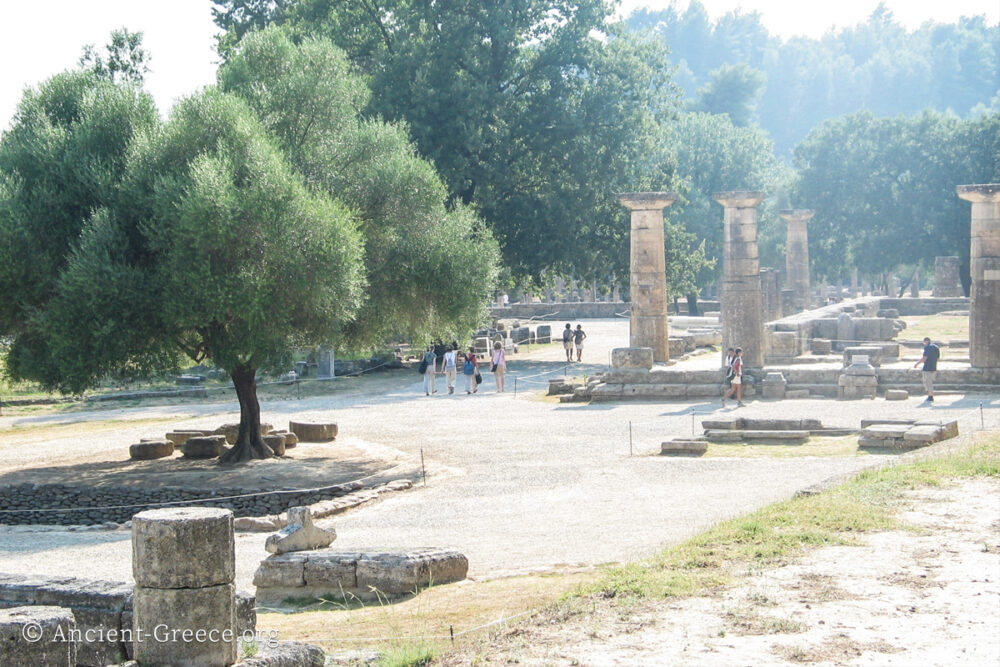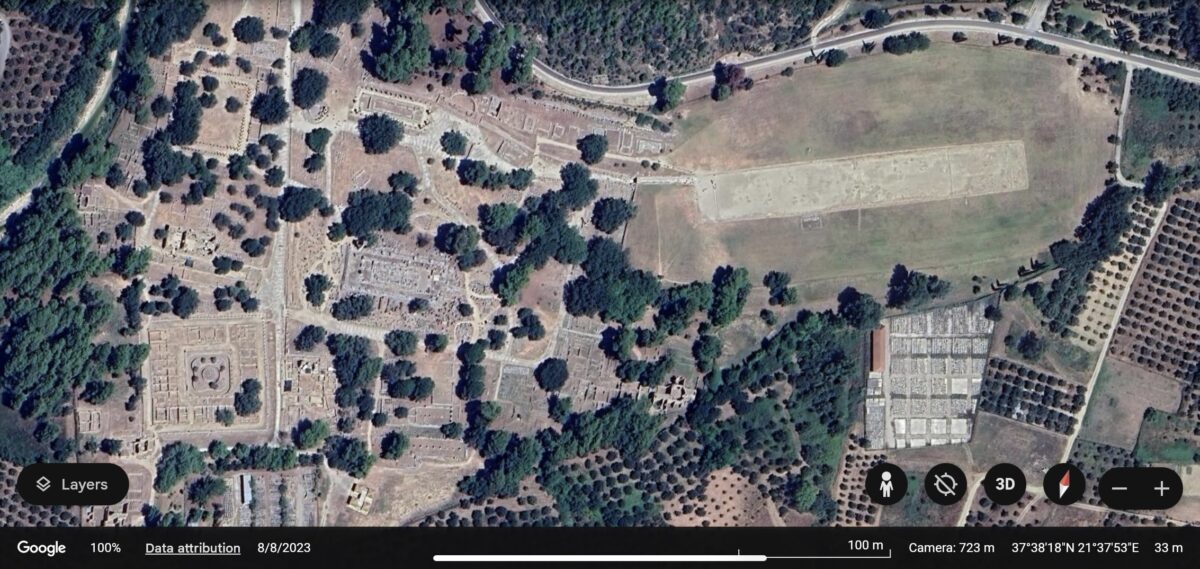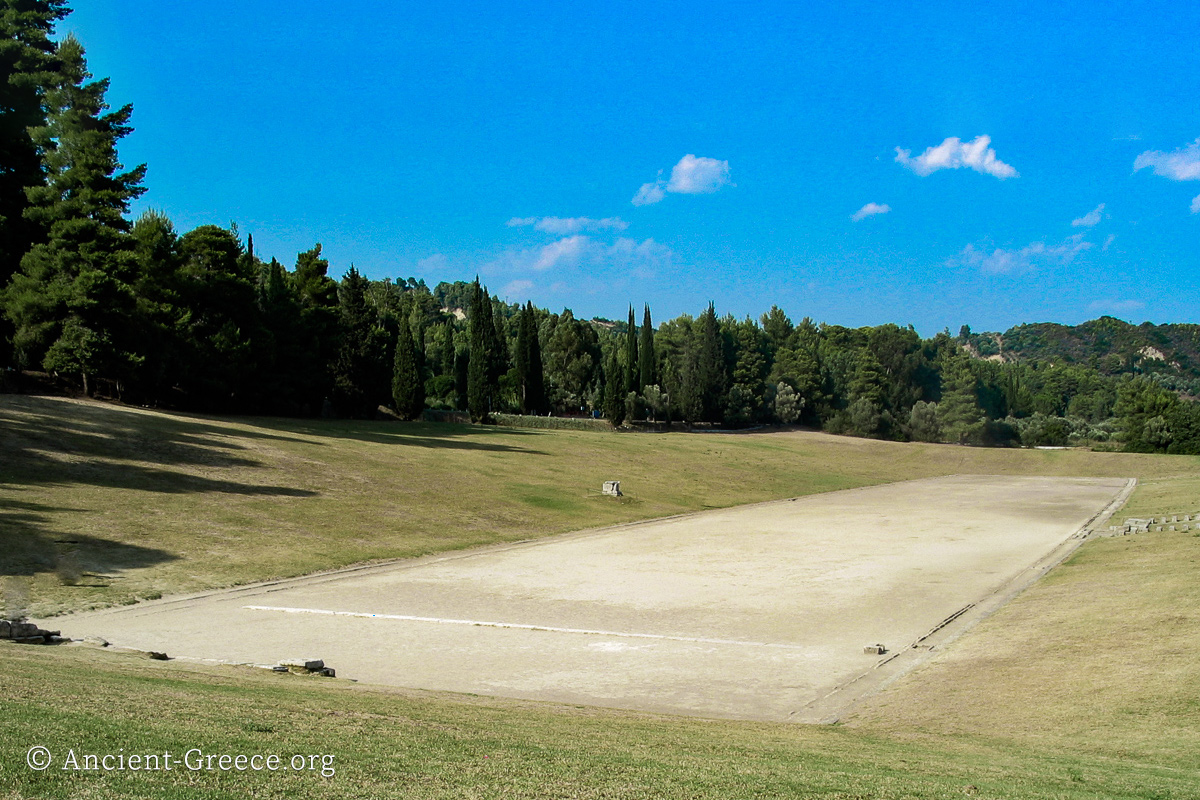
On this page:
Olympia (Greek: Ολυμπία) is one of the most influential ancient Greek sanctuaries. It has been renown since antiquity as the founder and host of the Olympic Games which took place every four years, starting in 776 BCE.
Olympia archaeological site is nestled in a fertile valley at the confluence of the Alpheios and the Kladeos rivers, within walking distance of the modern village called Ancient Olympia, in Elis, in western Peloponnese.
The sanctuary ruins span roughly 3000 years, from the about 2000 BCE to the 7th century CE.
The site includes an expansive area of ruins scattered among low trees, as well as the ancient stadium where the Olympics took place. An impressive array of artifacts which were unearthed during excavations are on exhibition at the nearby Olympia Museum.
Bronze Age Ruins


Apsidal Building III.
Several Apsidal Buildings dating back to the Middle Bronze Age (2000 – 1550 BCE) are located near the Temple of Hera.
Apsidal house III (2150 x 2000 BCE) is one of several similar buildings excavated at Olympia. In it archaeologist found a plethora of vases with foreign incised decorative motifs showing a connection with the Cetina culture of the Dalmatian coast.
The Heraion





The Heraion. The very ancient Doric temple of Hera is located at the foot of the Kronios hill, in the holiest spot of the Altis (Andronicos, 32). Late 7th c. BCE
The Ancient Olympic Stadium








The ancient Olympic Stadium at Olympia.
As it was customary in early Greek stadiums, the spectators sat on the slopes and the only stone seats were for the judges (hellanodikai).
The stadium’s course is about 200 yards long, which is equivalent to 600 Olympic feet (Andronicos, 41), or 191.78 meters long (Mee & Spawforth, 291). The capacity of the stadium is estimated at 40,000 spectators.
The present restoration emulates a 4th c. BCE version with later additions, which was built on an earlier, smaller stadium.
Visible in these photos are the starting blocks of the Olympic stadium which were made of marble and had notches cut where runners would place their feet, as well as the bases of the hysplex, the catapult-like mechanism of posts and rope that ensured no runner jumped ahead before the staring command.
The platform of the Hellanodikai and the surrounding water drain are also visible in these photos.
Read more about the Olympic Games
Temple of Zeus




The temple of Zeus.
The architect of the Doric temple was Libon of Elis, and it was dedicated in 457 BCE when the Lakedaimonians, in celebration of their victory against the Athenians in Tanagra, placed a solid gold shield on the acroterion of the temple.
While today it appears in ruins, thet temple of Zeus was the largest one in the Peloponnese, measuring 27.68 m x 64.12 m (Andronicos, 18).
Palaestra, Leonidaion, and Philippeion






Top row: The Palaestra
Bottom: Leonidaion, and the Philippeion.
The Palaestra was built in the Hellenistic era, and was used as the living and training ground for the wrestling and pankration athletes.
The Leonidaion was a large guest house for visiting officials, and it was the donation of a wealthy Naxian, Leonidas in the 4th c. BCE.
The Philippeion was a memorial tholos (circular building) in Olympia was built by Phillip II, and was finished by his son Alexander the Great at the end of 4th c. BCE.
Treasuries and Nymphaion


Left: The ruins of the Nymphaion–a fresh water fountain. It was erected in 153 CE by Herodes Atticus to be the terminal of a newly constructed aqueduct.
Right: The Sicyonion (The treasury of Sicyon) among ruins of the treasuries of Olympia. It was one of the treasuries on the south slope of Kronos hill in ancient Olympia. These treasuries were dedicated by various Greek colonies. The Sikyoninans had also dedicated another treasury at the sanctuary of Delphi.
Late Ruins and Views







Pheidias’ workshop and other ruins from Olympia archaeological site.
Pheidias’ workshop was identified by a cup excavated from the ruins of the later Christian basilica with the inscription “Φειδιο ειμι” (I belong to Pheidias).
Archaeological Site Plan


Archaeological site of Olympia plan and annotated perspective reconstruction showing how the sanctuary might have looked like in ancient times.






